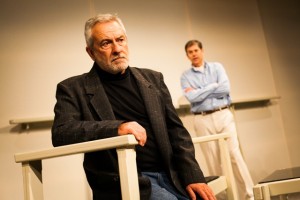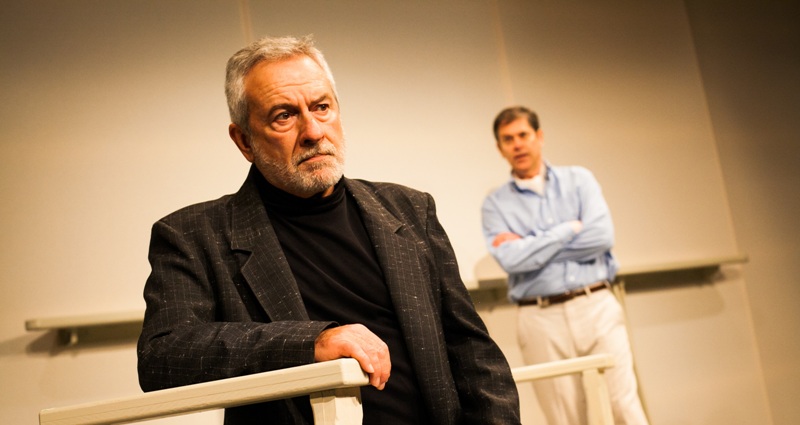
Tom Teti and Leonard Haas in a scene from Hedgerow Theatre's production of ART, running in Rose Valley, PA through June 17.
What defines a friendship? Is it shared values? Similar interests? Common social background? It’s kinda hard to pin down, isn’t it? Another question: do all friendships run their course? Is it inevitable that eventually we’ll drift apart? Will life circumstances change us in some fundamental way so that we no longer have anything in common with one of our friends?
Yasmina Reza examines friendship in her 1994 comic riff, ART. Reza has said, “I have the feeling that friendship is at least as strong and as difficult as love. We are used to thinking that it is easier to be a friend…but that is not so.” Her play, translated to English by Christopher Hampton, involves three well-to-do, middle-aged Parisian men, Marc (Tom Teti), Serge (Lenny Haas) and Yvan (Zoran Kovcic), who have seen each other through many life changes by the time we meet them: marriages, parenthood, divorces, job losses… Serge is a prominent dermatologist and he has just spent 200,000 francs [about $40,000, I think] for a white-on-white painting. This seriously peeves Marc, an aeronautical engineer, who cannot fathom why the friend he thought he knew would spend so much on what he feels is basically a blank canvas. He believes Serge’s purchase completely undermines everything he thought he knew about his friend. It would be akin to an uber-liberal finding out that their friend had joined the Tea Party.
Caught in the middle is poor schlemiel Yvan, who is a walking bundle of neuroses about to get married to a woman who may not be the best person for him. Yvan’s persistent neutrality only amps things up between Serge and Marc as each one presses his point of view. What both Marc and Serge view as Yvan’s failure to commit also seems to symbolize his floundering life—he has not been nearly as successful as his two compatriots. The bickering continues to escalate as each man reveals something about themselves—and slowly reveal their perceptions of the others. The viewer soon realizes that the painting is just the catalyst that brings underlying issues to the surface.
During my research for this piece, I learned that the context of the play was born out of an encounter Reza had with one of her own friends: Serge Goldszal, to whom she dedicated the play. He bought a painting similar to the white-on-white which is the focus of ART and showed it to Reza. She described the moment as follows: “I laughed and said, ‘You must be mad.’ and then we both laughed. He loves the painting and knew I might not, and we laughed because our complicity was in no way spoiled. But if he hadn’t laughed and had thought that the choice revealed his friends in another light…”
Kovcic has provided his co-stars with a metaphorical set to play upon. Walls of white painter’s canvas create the playwright’s vision of “a single set; as stripped-down and neutral as possible.” The action moves from Serge’s flat to Yvan’s to Marc’s and back in a continuing pastiche of scenes. Reza stipulates that even though we move locales, “Nothing changes, except for the painting on the wall.” And those reveal a great deal about each man as well. Marc, the classicist, has a landscape of Carcassonne—very grounded in realism, like its owner. Yvan has a rather anemic piece that the other two describe as a “motel painting.” We find out in a later scene that it was painted by his late father. Kovcic’s design brings to mind frames; there are lots of squares (including the few pieces of furniture), all painted in a slightly off-white. A real challenge for lighting designer John Tiedeck—how to avoid shadows. Tiedeck does a wonderful job. And his sound design is appropriately supportive as well. Cathy Miglionico’s costumes give clues about each man’s mindset also: Serge is neatly crisp, while Yvan is a rumpled, baggy mess.
Director Penelope Reed has opted to go for the laughs in Hedgerow’s production, pacing the 90-minutes nicely and adding more physical shtick than I’ve seen in other iterations of the piece. Teti and Haas have shared the stage a number of times during their long tenure as company members at People’s Light & Theatre Company. They have a natural ease together that brings verisimilitude to their playing friends. Teti started out at Hedgerow and has returned to his roots numerous times, performing with Kovcic periodically. These past relationships are a big plus to the production; the three actors are very believable as friends.
All three are also very gifted comedic actors. Teti is a master of the slow boil, Haas oozes suaveness and Kovcic really nails nebbish. As the run progresses, I’m sure they will find even more of the nuances in this script, and keep it fresh by exploring those levels of friendship Reza is writing about. And make it even funnier, too.
ART
by Yasmina Reza
Translated by Christopher Hampton
Directed by Penelope Reed
May 10—June 17, 2012
Hedgerow Theatre
64 Rose Valley Road
Media, PA
610-565-4211
www.hedgerowtheater.org


